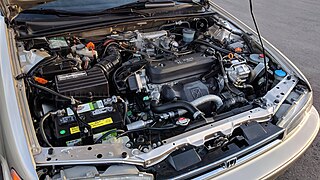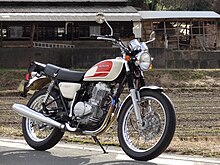
The Toyota Supra is a sports car and grand tourer manufactured by the Toyota Motor Corporation beginning in 1978. The name "supra" is derived from the Latin prefix, meaning "above", "to surpass" or "go beyond".

The CB Series is an extensive line of Honda motorcycles. Most CB models are road-going motorcycles for commuting and cruising. The smaller CB models are also popular for vintage motorcycle racing. The related Honda CBR series are sport bikes.
The Honda XR series is a range of four-stroke off-road motorcycles that were designed in Japan but assembled all over the world.

The Honda CR-X del Sol is a two-seater targa-top car manufactured by Honda from 1992 until 1998. Despite the body resemblance to a mid-engine car design, the del Sol is based on the front-engined Honda Civic platform and was the successor to the Honda CR-X.

A multi-valve or multivalve engine is one where each cylinder has more than two valves. A multi-valve engine has better breathing, and with more smaller valves may be able to operate at higher revolutions per minute (RPM) than a two-valve engine, delivering more power.
The Honda B20A engine series, known as the B20A and B21A, was an inline four-cylinder engine family from Honda introduced in 1985 in the second-generation Honda Prelude. Also available in the contemporary third-generation Honda Accord in the Japanese domestic market, along with the Accord-derived Vigor, the B20A was Honda's second line of multivalve DOHC inline four-cylinder engines behind the "ZC" twin-cam variant of the ordinarily SOHC D-series, focused towards performance and displacing 2.0 to 2.1 litres.

The E-series was a line of inline four-cylinder automobile engines designed and built by Honda for use in their cars in the 1970s and 1980s. These engines were notable for the use of CVCC technology, introduced in the ED1 engine in the 1975 Civic, which met 1970s emissions standards without using a catalytic converter.

The J-series is Honda's fourth production V6 engine family introduced in 1996, after the C-series, which consisted of three dissimilar versions. The J-series engine was designed in the United States by Honda engineers. It is built at Honda's Anna, Ohio, and Lincoln, Alabama, engine plants.

The Honda D series inline-four cylinder engine is used in a variety of compact models, most commonly the Honda Civic, CRX, Logo, Stream, and first-generation Integra. Engine displacement ranges between 1.2 and 1.7 liters. The D Series engine is either SOHC or DOHC, and might include VTEC variable valve lift. Power ranges from 66 PS (49 kW) in the Logo to 130 PS (96 kW) in the Civic Si. D-series production commenced in 1984 and ended in 2005. D-series engine technology culminated with production of the D15B 3-stage VTEC (D15Z7) which was available in markets outside of the United States. Earlier versions of this engine also used a single port fuel injection system Honda called PGM-CARB, signifying the carburetor was computer controlled.

The Vulcan name has been used by Kawasaki for their custom or touring bike since 1984, model designation VN, using mostly V-twin engines ranging from 398 to 2,053 cc.

The Honda F-Series engine was considered Honda's "big block" SOHC inline four, though lower production DOHC versions of the F-series were built. It features a solid iron or aluminum open deck cast iron sleeved block and aluminum/magnesium cylinder head.

The Honda CB400F is a motorcycle produced by Honda from 1975 to 1977. It first appeared at the 1974 Cologne motorcycle show, Intermot, and was dropped from the Honda range in 1978. It had an air-cooled, transverse-mounted 408 cc (24.9 cu in) inline four-cylinder engine with two valves per cylinder operated by a single chain-driven overhead camshaft. Fuelling was provided by four 20 mm Keihin carburettors. The CB400F is commonly known as the Honda 400 Four.

A motorcycle engine is an engine that powers a motorcycle. Motorcycle engines are typically two-stroke or four-stroke internal combustion engines, but other engine types, such as Wankels and electric motors, have been used.

The L-series is a compact inline-four engine created by Honda, introduced in 2001 with the Honda Fit. It has 1.2 L (1,198 cc), 1.3 L (1,318 cc) and 1.5 litres (1,497 cc) displacement variants, which utilize the names L12A, L13A and L15A. Depending on the region, these engines are sold throughout the world in the 5-door Honda Brio Fit/Jazz hatchback Honda Civic and the 4-door Fit Aria/City sedan. They can also be found in the Japanese-only Airwave wagon and Mobilio MPV.

The Honda CB500 Four is a standard 498 cc (30.4 cu in), air-cooled, 8-valve, SOHC, transverse inline-four motorcycle made by Honda from 1971 to 1978. It was introduced at the London Racing and Sporting Motorcycle Show in February 1972, and sold in the US market until 1973, replaced by the CB550 in the 1974 model year, while continuing in the European market until 1978. The CB500 Four is styled like the CB750, but smaller and lighter, with a claimed 50 bhp (37 kW) output and a top speed of 115 mph (185 km/h).

The Mitsubishi 3G8 engine is a range of three-cylinder powerplant from Mitsubishi Motors, introduced in the fifth generation of their Mitsubishi Minica kei car. In common with other contemporary engines in the class, it could be specified with many advanced technologies despite its diminutive size, including multi-valve cylinder heads and double overhead camshafts. The top-of-the-line Dangan ZZ variant was also the first kei car to benefit from turbocharging. In 1987 Mitsubishi was the first manufacturer to supercharge a kei vehicle, and in 1989 became the world's first production car to feature five valves per cylinder, ahead of similar developments by Bugatti, Audi, Ferrari and Toyota.

The Corolla E90 was the sixth generation of cars sold by Toyota under the Corolla nameplate, introduced in 1987 for the 1988 model year. It was the last generation of Corolla to be classified as a subcompact car and the first to be exclusively front-wheel drive or all-wheel drive; the performance option of rear-wheel drive was dropped.

The Honda CM450A is a motorcycle made by Honda in 1982 and 1983. It was based on the CB400 and CM400 models (1978–1981), especially the CM400A Hondamatic (1980–1981). It had a 447 cc (27.3 cu in) SOHC parallel twin engine with two carburetors and a two-speed transmission with a torque converter. It was not a full automatic, however, because the rider had to manually shift between low and high. It is called automatic because there is no clutch required due to the torque converter, and shared the Hondamatic trade name with Honda cars that had true automatic transmissions. The chain-driven CM450A had a top speed of 90 miles per hour (140 km/h) and weighed 413 pounds (187 kg). Both models had a front disc brake and a rear drum brake. The suspension consisted of two shock absorbers at the rear and telescoping shock-absorbing front forks. The fuel tank had a 3.4 US gallons capacity. The exhaust was routed through a separate pipe and baffle on each side of the motorcycle, although both exhaust pipes shared a plenum under the motor. It had an electric start with a kick start as well.

The Honda CB400T is a range of motorcycles built by Honda. In the United Kingdom it was known as the Dream, whereas in the United States it was known as the Hawk. A Honda CB250T version was also available in some markets including the UK and Australia for licensing reasons.



















